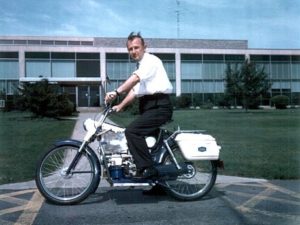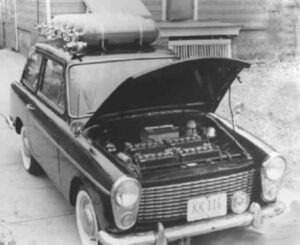“Electric cars are going to be very important for urban transportation.” Carlos Ghosn, CEO Nissan-Renault
The back yard – behind factory buildings- is just where General Motors tested the first earthbound, – better to say road-bound – fuel cell electric vehicle. FCEV is Toyota’s term for the Mirai to clarify that a fuel cell vehicle IS an electric vehicle. CARandDRIVER magazine also calls the Honda Clarity and Hyundai Tucson FCEVs. At least one respected Greater Toronto Area (GTA) Audi, Porsche, and Volkswagen group I know of have taken to name this new species in that way. So let’s add the ‘E’ to FC V and forever let it be known that a fuel cell vehicle is indeed an electric motor car. — BTW, ‘motorcar’ is —let’s make that was— the familiar, but the completely wrong term for cars of the ICE age, which have an engine.
Let me ramble on: ‘motor’ sounds so smooth and rounded, whereas ‘engine’ sounds “staccato” just like the reciprocation, or ‘back and forth/up & down’ it endures.
Now back to the reality of history.
We cannot forget that Allis-Chalmers’ had been FIRST with an FCEV (off-road) farm tractor. In 1966, General Motors together with Union Carbide experimented with a hydrogen-fuelled, fuel cell powered ‘Electrovan’. The cells directly energized the electric motor – batteries not included. (Is this where that started?) That familiar sales pitch also applies to this hilarious EV story, which came as I was proofreading this article.
As many other ‘firsts’, the GM Electrovan was rudimentary, unreliable, and it was only tested on the back-roads of factory properties for safety reasons. From the few publicly available reports, we can read between the lines that the technology was not yet ready for the road. The project was soon abandoned; nevertheless, it was another FIRST.
The above link has a very large phantom drawing of the ‘Electrovan’, (also described here by ‘Hydro Kevin Kantola’) Early installation of fuel cell apparatus left room for only driver and one passenger. At a weight of 3400 kg, the van’s Union Carbide 5 kW cell was fuelled with liquid hydrogen. The Electrovan had a range of 200 km and a top speed of 105 km/h. Its operating time was extended to several hours; fuel cell life was only 1000 hours. Illustration from General Motors.
Fifty years later, in 2016, General Motors is now proudly presenting and celebrating their ‘Electrovan’ together with its recent models of FCEV prototypes at the show Propulsion after Petroleum in one of the better-known automotive museum in the USA, the ‘Petersen’.
Back in the 1960s, the Austrian-born Dr. Karl Kordesch, one of Union Carbide’s researchers, was taking part in the construction of the Electrovan’s power-plant. An eminent battery specialist with many, many patents to his name, he continued to refine the alkaline fuel cell. In 1967 he attached one to a moped, which he used to travel around town.
Dr. Kordesch at his workplace in Boston. The original Union Carbide caption: “It looks like an ordinary motorbike but there’s no internal combustion engine and there’s no noise. The machine, which is powered by a hydrazine-air fuel cell system, was built under the direction of Union Carbide’s Dr. Karl Kordesch, a pioneer in fuel cell development. Dr. Kordesch has run up over 300 miles on the motorbike which can do 25 miles an hour and can travel 200 miles on a gallon of hydrazine.” Illustration from Union Carbide.
In 1970 Kordesch took his Austin A 40 and used it as an FCEV “mule”, today’s term for experimental prototype vehicles. He sacrificed the Austin’s trunk (picture at History of Hydrogen Cars, first link) to hold the fuel cell, and six roof-mounted tanks held the hydrogen at a much lower pressure than what can safely be used today. He installed a group of lead-acid batteries in the engine compartment, under the bonnet, as the British say. With that, the “Austin FCEV” had a range of about 300 km (180 miles). Kordesch drove that Austin on a regular basis for three years, commuting to and from work, going shopping, being looked upon and tolerated by the public as just another ‘mad scientist’ in his hometown of that time, Boston.
A ‘battery’ of batteries under the bonnet (hood) of the Austin A40. Photo from Union Carbide Corporation.
As an electrochemist and physicist, Dr. Kordesch is as familiar with hydrogen and fuel cells as anybody could ever hope to be. He was the first person to drive an FCEV on public roads – a generation ago.
Such is the complex nature of the simple hydrogen element and “the engine of the 21st century”, that after all this time we still do not have hydrogen-powered fuel cell electric vehicles in everyone’s driveways.
A true ‘citizen of the world’, Kordesch was in high demand in his home country, Austria, where he lead University research teams. After working at Union Carbide in the United States, he founded Batteries Technologies Incorporated in Toronto, Canada, and later Kordesch & Associates, a consulting company. His expertise did benefit the Canadian Research Council, the European Space Agency, the Dornier aircraft company, Siemens electronic supply company, Austria’s Graz Technical University and much more.
Karl Kordesch passed away in 2011 at 89 years of age.
During the 1960s and 1970s, another scientist, Roger Billings also experimented with hydrogen fuel cells with help from Ford. Involved in several other ventures, he spread the claim to have “invented the first fuel cell car in 1966.” Really!?
Suddenly, the priorities of industrialized nations around the globe changed in a monumental way: The 1973 oil crisis gave us a short forewarning of how to live and work without precious petroleum. With this link, please allow me to promote my Amazon-Kindle eBook series ‘Racing to Preserve Precious Petroleum’ and ‘Racing to Preserve our Precious Planet’.
Next: Countries Advancing Hydrogen and Fuel Cell History


